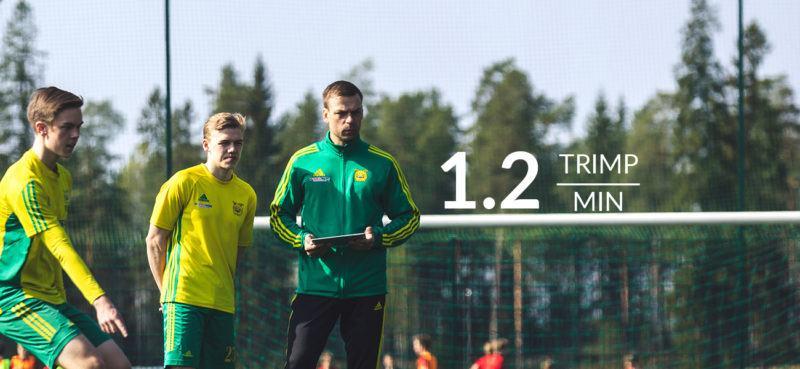
Saracens rugby club are the most successful Premiership Rugby side of the last decade, taking four titles in just five seasons between 2014 and 2019. Now, they’re back in the top flight after a year’s hiatus and preparing to continue where they left off.
We spoke to Lead Sports Scientist Tom Sherriff about how he and his colleagues use Firstbeat Sports to help keep one of the best squads in European rugby at the peak of their powers.
For several years now, Saracens have analyzed metrics as part of their preparation for every fixture in a packed schedule. They have used Firstbeat Sports’ heartbeat monitoring system since 2007 to track internal physiological metrics and inform decisions ranging from load management to player rehab.
Real Time
One metric the four-time Premiership champions track during training sessions is time spent above 85% of maximal heart rate. Watching each individual player’s heart rate fluctuate within a session (each player wears a lightweight heart rate belt around their chest), Sherriff and his colleagues can gain real-time insight into the intensity of sessions and gauge whether correct demands are being placed on players at the right time.
“It means we can know where we are and want to be, even in the middle of a session.” Sherriff explains. “And players can check it too via the dashboard. Especially on more intense days, they can make sure they’re hitting their targets.”
Coaches and players are aware of exactly what impact the ongoing session is having on player load. And, depending on if players are spending too much (or too little) time above 85% of their maximum heart rate, it can lead to changes being made to a session in real-time.
“It helps up nail what we want to do,” says Sherriff. “If it is meant to be a light, low intensity session I can see the data and chirp up if we’re creeping into the red intensity zone a little bit too much. Conversely, if we’re trying to make sure it is tough, and the data shows it isn’t tough enough then we can change what we do to get the response we want. Firstbeat has helped with that massively for the on-field stuff.”
Making changes mid-session depends on the importance of intensity within that session, but examples of this can be adjusting training game rules to increase intensity or flagging certain players for more fitness work if their numbers are low.
Breading Competition
And, as is natural with elite level athletes, there is an almost inevitable competitive element for players when they seek out their own data.
“Because Firstbeat’s system can show everyone’s results on one page you do get increased competition and that does help drive training standards,” Sherriff reveals.
Saracens have previously used heart rate data collected by Firstbeat to set player targets and, whether looking at accumulated weekly loads or single session intensity levels, the Premiership champions have seen it lead to increased competition within the squad to outdo each other.
Even if it is an individual session, once players get close to a max heart rate then something else kicks in and there is a kind of internal battle. And we get some good quality training outcomes based off that.”
All Areas
Saracens aren’t just using Firstbeat data to react to internal physiology and adjust during team sessions. Monitoring metrics like HRmax over the entire season allows staff to be aware of ongoing trends and pass on necessary information to senior members of the coaching team when required – in turn helping decisions to be backed up by objective data rather than a hunch.
Led by head coach Mark McCall, Saracens have nurtured a culture where data has become a big part of day-to-day activity beyond the training field.
“It’s a big part of the off-field conditioning work we do,” Sherriff continued. “With players who are working in the gym – either involved in rehab or as part of a long-term conditioning focus where we don’t want them to be doing extra meters on feet – they’re used to seeing the Firstbeat numbers.”
“It is intuitive and, because we use it everywhere from rugby to conditioning and we have used it in matches, players know what a good figure is for them for each of their metrics. So we get good buy-in.
“We’ll use different screens in the gym when they’re using the bikes or their cross trainers etc. It is something that is essentially everywhere really, not just on the pitches.”
Building a Culture
This positive culture – where everyone from the head coach, to strength and conditioning staff, to the athletes are aware of the value of the data being collected – is combined with an organized process for collecting the data. Sherriff and his team can streamline the data into manageable, actionable information that can be used to do what matters most, putting the team in the best position to win.
“We’ve distilled Firstbeat data mainly into HR, minutes in intensity zones and TRIMP (Training Impulse) when communicating it to the coaching staff, to make it an efficient process” Sherriff explains.
“The data will be presented in a color-coded table in two ways. One will be based on how an individual compares to other players who did that activity. Secondly, we have a ‘Z’ score showing how a player compares to what we’d normally see from them. So, we get two layers of comparison.
“Mark (McCall) will often pick up on something in the data and get in touch with me and ask, ‘What do you think is going on?’. Or, conversely, if I notice something in real-time, analyse it and look at other data sources with it, I’m more than comfortable with going to Mark with a thought-out process.
“Essentially, Firstbeat has never let us down. It does what we need, and it does it well.”
Download our free guide to “Understanding the Athlete Training Load”
Give your team the Firstbeat Sports competitive advantage.
Contact us for more information or get a quote.
You might also be interested in

Introducing Firstbeat Sports Sensor and Live app
Bringing Focus and Mobility to Coaching Firstbeat Sports, the provider of the most comprehensive internal training load analyses in team sports monitoring, is today launching Firstbeat Sports Sensor and Live app*. The next generation solution…

Real-time TRIMP/min: How to Use the Firstbeat Sports App Feature in Training
From replicating game intensity to aiding player rehab, monitoring TRIMP/min has wide-ranging benefits.

